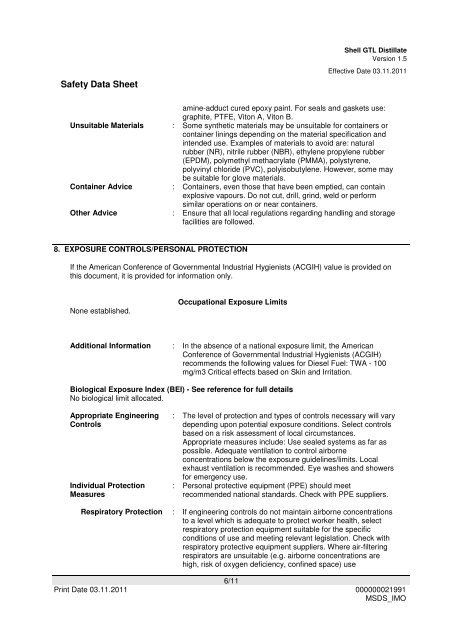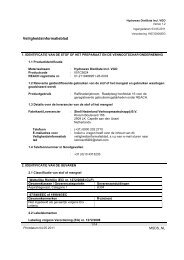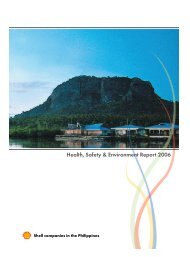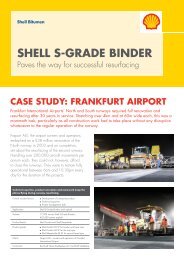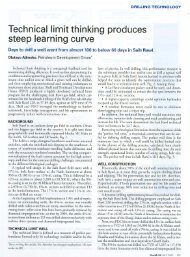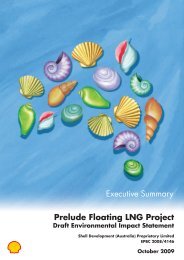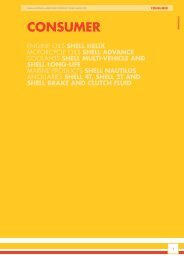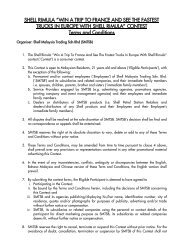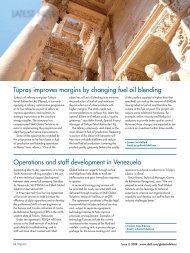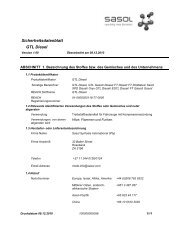Safety Data Sheet - Shell
Safety Data Sheet - Shell
Safety Data Sheet - Shell
Create successful ePaper yourself
Turn your PDF publications into a flip-book with our unique Google optimized e-Paper software.
<strong>Safety</strong> <strong>Data</strong> <strong>Sheet</strong><br />
<strong>Shell</strong> GTL Distillate<br />
Version 1.5<br />
Effective Date 03.11.2011<br />
amine-adduct cured epoxy paint. For seals and gaskets use:<br />
graphite, PTFE, Viton A, Viton B.<br />
Unsuitable Materials : Some synthetic materials may be unsuitable for containers or<br />
container linings depending on the material specification and<br />
intended use. Examples of materials to avoid are: natural<br />
rubber (NR), nitrile rubber (NBR), ethylene propylene rubber<br />
(EPDM), polymethyl methacrylate (PMMA), polystyrene,<br />
polyvinyl chloride (PVC), polyisobutylene. However, some may<br />
be suitable for glove materials.<br />
Container Advice : Containers, even those that have been emptied, can contain<br />
explosive vapours. Do not cut, drill, grind, weld or perform<br />
similar operations on or near containers.<br />
Other Advice : Ensure that all local regulations regarding handling and storage<br />
facilities are followed.<br />
8. EXPOSURE CONTROLS/PERSONAL PROTECTION<br />
If the American Conference of Governmental Industrial Hygienists (ACGIH) value is provided on<br />
this document, it is provided for information only.<br />
None established.<br />
Occupational Exposure Limits<br />
Additional Information : In the absence of a national exposure limit, the American<br />
Conference of Governmental Industrial Hygienists (ACGIH)<br />
recommends the following values for Diesel Fuel: TWA - 100<br />
mg/m3 Critical effects based on Skin and Irritation.<br />
Biological Exposure Index (BEI) - See reference for full details<br />
No biological limit allocated.<br />
Appropriate Engineering<br />
Controls<br />
Individual Protection<br />
Measures<br />
: The level of protection and types of controls necessary will vary<br />
depending upon potential exposure conditions. Select controls<br />
based on a risk assessment of local circumstances.<br />
Appropriate measures include: Use sealed systems as far as<br />
possible. Adequate ventilation to control airborne<br />
concentrations below the exposure guidelines/limits. Local<br />
exhaust ventilation is recommended. Eye washes and showers<br />
for emergency use.<br />
: Personal protective equipment (PPE) should meet<br />
recommended national standards. Check with PPE suppliers.<br />
Respiratory Protection : If engineering controls do not maintain airborne concentrations<br />
to a level which is adequate to protect worker health, select<br />
respiratory protection equipment suitable for the specific<br />
conditions of use and meeting relevant legislation. Check with<br />
respiratory protective equipment suppliers. Where air-filtering<br />
respirators are unsuitable (e.g. airborne concentrations are<br />
high, risk of oxygen deficiency, confined space) use<br />
6/11<br />
Print Date 03.11.2011 000000021991<br />
MSDS_IMO


